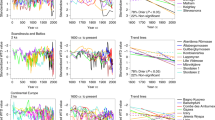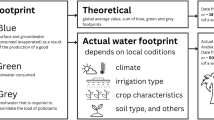Abstract
Peatlands cover approximately 2.84% of the Earth’s land surface and store around 10% of all non-glacial freshwater. However, the contribution of peatlands to global potable water resources is unclear because most peatlands are remote from major population centres, and until now no systematic, global assessment of peatland water resources has been undertaken. Here we analyse global peatland, population and hydrometric datasets to identify hotspots where peatlands are crucial for water supply, and show that these peat-rich catchments deliver water to 71.4 million people. Water-supply peatlands cover just 0.0015% of the global land surface, yet provide 3.83% of all potable water stored in reservoirs. Approximately 85% of all drinking water delivered directly from peatlands is consumed in the United Kingdom and the Republic of Ireland, meaning that peatlands play crucial roles in the water security of these nations. Globally, only 28% of water-supply peatlands are pristine or protected, highlighting the urgent need for responsible stewardship. Our findings provide global evidence for the often assumed role of peatlands in sustainable water resource provision and for informing peatland water-resource protection policies.
This is a preview of subscription content, access via your institution
Access options
Access Nature and 54 other Nature Portfolio journals
Get Nature+, our best-value online-access subscription
$29.99 / 30 days
cancel any time
Subscribe to this journal
Receive 12 digital issues and online access to articles
$119.00 per year
only $9.92 per issue
Buy this article
- Purchase on Springer Link
- Instant access to full article PDF
Prices may be subject to local taxes which are calculated during checkout



Similar content being viewed by others
References
Xu, J., Morris, P. J., Liu, J. & Holden, J. PEATMAP: refining estimates of global peatland distribution based on a meta-analysis. Catena 160, 134–140 (2018).
Parish, F. et al. Assessment on Peatlands, Biodiversity and Climate Change: Main Report (Global Environment Centre, 2008); http://www.imcg.net/media/download_gallery/books/assessment_peatland.pdf
Joosten, H. & Clarke, D. Wise Use of Mires and Peatlands (International Mire Conservation Group and International Peat Society, 2002).
Page, S. & Rieley, J. Tropical peatlands: a review of their natural resource functions, with particular reference to Southeast Asia. Int. Peat J. 8, 95–106 (1998).
Watts, C. D., Naden, P. S., Machell, J. & Banks, J. Long term variation in water colour from Yorkshire catchments. Sci. Total Environ. 278, 57–72 (2001).
Ritson, J. P. et al. Simulated climate change impact on summer dissolved organic carbon release from peat and surface vegetation: Implications for drinking water treatment. Water Res. 67, 66–76 (2014).
Fenner, N. & Freeman, C. Drought-induced carbon loss in peatlands. Nat. Geosci. 4, 895–900 (2011).
Clark, J. M. et al. Assessing the vulnerability of blanket peat to climate change using an ensemble of statistical bioclimatic envelope models. Clim. Res 45, 131–U462 (2010).
Moore, S., Gauci, V., Evans, C. D. & Page, S. E. Fluvial organic carbon losses from a Bornean blackwater river. Biogeosciences 8, 901–909 (2011).
Strack, M. Peatlands and Climate Change (International Peat Society, 2008).
Pastor, J. et al. Global warming and the export of dissolved organic carbon from boreal peatlands. Oikos 100, 380–386 (2003).
Schuur, E. A. G. et al. Vulnerability of permafrost carbon to climate change: Implications for the global carbon cycle. Bioscience 58, 701–714 (2008).
Li, P., Holden, J., Irvine, B. & Mu, X. Erosion of Northern Hemisphere blanket peatlands under 21st‐century climate change. Geophys. Res. Lett. 44, 3615–3623 (2017).
Turetsky, M. R. et al. Global vulnerability of peatlands to fire and carbon loss. Nat. Geosci. 8, 11–14 (2015).
Konecny, K. et al. Variable carbon losses from recurrent fires in drained tropical peatlands. Glob. Change Biol. 22, 1469–1480 (2016).
Worrall, F., Burt, T. P. & Adamson, J. K. Trends in drought frequency: the fate of DOC export from British peatlands. Climatic Change 76, 339–359 (2006).
Joosten, H. The Global Peatland CO Picture: Peatland Status and Drainage Related Emissions in All Countries of the World (Wetlands International, 2009).
Barid, A. J. et al. Carbon Cycling in Northern Peatlands (American Geophysical Union, 2009).
Holden, J. et al. Impact of prescribed burning on blanket peat hydrology. Water Resour. Res. 51, 6472–6484 (2015).
Tonks, A. J. et al. Impacts of conversion of tropical peat swamp forest to oil palm plantation on peat organic chemistry, physical properties and carbon stocks. Geoderma 289, 36–45 (2017).
Gibson, H. S., Worrall, F., Burt, T. P. & Adamson, J. K. DOC budgets of drained peat catchments: implications for DOC production in peat soils. Hydrol. Process. 23, 1901–1911 (2009).
Holden, J., Chapman, P. J. & Labadz, J. C. Artificial drainage of peatlands: hydrological and hydrochemical process and wetland restoration. Prog. Phys. Geogr. 28, 95–123 (2004).
Evans, C. D. et al. Contrasting vulnerability of drained tropical and high-latitude peatlands to fluvial loss of stored carbon. Glob. Biogeochem. Cy. 28, 1215–1234 (2014).
Moore, S. et al. Deep instability of deforested tropical peatlands revealed by fluvial organic carbon fluxes. Nature 493, 660–663 (2013).
Krecek, J. & Haigh, M. Environmental Role of Wetlands in Headwaters (Springer Netherlands, Dordrecht, 2006).
Chow, A. T., Tanji, K. K. & Gao, S. D. Production of dissolved organic carbon (DOC) and trihalomethane (THM) precursor from peat soils. Water Res. 37, 4475–4485 (2003).
Jenks, G. F. The data model concept in statistical mapping. Int. Yearb. Cartogr. 7, 186–190 (1967).
Bottcher, A. Everglades Agricultural Area (EAA): Water, Soil, Crop, and Environmental Management (Univ. Press of Florida, Gainesville, 1994).
Page, S. E., Rieley, J. O. & Banks, C. J. Global and regional importance of the tropical peatland carbon pool. Glob. Change Biol. 17, 798–818 (2011).
Yu, Z. C. Northern peatland carbon stocks and dynamics: a review. Biogeosciences 9, 4071–4085 (2012).
Li, P., Holden, J. & Irvine, B. Prediction of blanket peat erosion across Great Britain under environmental change. Climatic Change 134, 177–191 (2016).
Evans, M. & Warburton, J. Geomorphology of Upland Peat: Erosion, Form and Landscape Change (John Wiley and Sons, Hoboken, 2011).
Nachtergaele, F. & Petri, M. Mapping Land Use Systems at Global and Regional Scales for Land Degradation Assessment Analysis: Technical Report of the LADA FAO/UNEP Project (Food and Agriculture Organization of the United Nations, 2011).
Alexandratos, N. & Bruinsma, J. World Agriculture Towards 2030/2050: the 2012 Revision ESA Working paper (FAO, 2012).
Kechavarzi, C., Dawson, Q. & Leeds-Harrison, P. Physical properties of low-lying agricultural peat soils in England. Geoderma 154, 196–202 (2010).
Dawson, Q., Kechavarzi, C., Leeds-Harrison, P. & Burton, R. Subsidence and degradation of agricultural peatlands in the Fenlands of Norfolk, UK. Geoderma 154, 181–187 (2010).
Leifeld, J., Müller, M. & Fuhrer, J. Peatland subsidence and carbon loss from drained temperate fens. Soil Use Manag. 27, 170–176 (2011).
Couwenberg, J. Emission Factors for Managed Peat Soils: an Analysis of IPCC Default Values (Wetlands International, 2009); http://www.imcg.net/media/download_gallery/climate/couwenberg_2009a.pdf
Holden, J. et al. Water quality and UK agriculture: challenges and opportunities. WIREs Water 4, e1201 (2017).
White, P. J. & Hammond, J. P. The sources of phosphorus in the waters of Great Britain. J. Environ. Qual. 38, 13–26 (2009).
Stanley, E. H., Powers, S. M., Lottig, N. R., Buffam, I. & Crawford, J. T. Contemporary changes in dissolved organic carbon (DOC) in human‐dominated rivers: is there a role for DOC management? Freshw. Biol. 57, 26–42 (2012).
England's Peatlands – Carbon Storage and Greenhouse Gases NE257 (Natural England, 2010).
Evans, C. D., Monteith, D. T. & Cooper, D. M. Long-term increases in surface water dissolved organic carbon: Observations, possible causes and environmental impacts. Environ. Pollut. 137, 55–71 (2005).
Ritson, J. P. et al. The impact of climate change on the treatability of dissolved organic matter (DOM) in upland water supplies: A UK perspective. Sci. Total Environ. 473-474, 714–730 (2014).
Whitfield, S. et al. Managing peatland ecosystem services: current UK policy and future challenges in a changing world. Scott. Geogr. J. 127, 209–230 (2011).
Multimillion pound investment will ensure a continued secure and reliable high-quality drinking water supply. South Staffs Water (13 April 2017); https://www.south-staffs-water.co.uk/news/multimillion-pound-investment-will-ensure-a-continued-secure-and-reliable-high-quality-drinking-water-supply
£4 million investment at Tankersley waste water treatment works. Yorkshire Water (23 January 2017); https://www.yorkshirewater.com/about-us/newsroom-media/tankersley-treatment--works
Worrall, F., Armstrong, A. & Holden, J. Short-term impact of peat drain-blocking on water colour, dissolved organic carbon concentration, and water table depth. J. Hydrol. 337, 315–325 (2007).
Menberu, M. W. et al. Changes in pore water quality after peatland restoration: Assessment of a large-scale, replicated Before-After-Control-Impact study in Finland. Water Resour. Res. 53, 8327–8343 (2017).
Martin-Ortega, J., Allott, T. E., Glenk, K. & Schaafsma, M. Valuing water quality improvements from peatland restoration: Evidence and challenges. Ecosyst. Serv. 9, 34–43 (2014).
Lehner, B. et al. Global Reservoir and Dam (GRanD) Database Version 1.1 (Department of Georgraphy, McGill Univ., 2011); http://www.gwsp.org/fileadmin/downloads/GRanD_Technical_Documentation_v1_1.pdf
Lehner, B. HydroSHEDS Version 1.2 (World Wildlife Fund US, 2013); http://hydrosheds.org/images/inpages/HydroSHEDS_TechDoc_v1_2.pdf
Lehner, B. & Grill, G. Global river hydrography and network routing: baseline data and new approaches to study the world's large river systems. Hydrol. Process 27, 2171–2186 (2013).
ESRIArcGISDesktop Release 10.4 (Environmental Systems Research Institute, 2016).
Baby, S., Nagyvaradi, L. & Balassa, B. Choropleth mapping and interpolation technique to analyze the demographic influence on kuwait's coastal morphological landscape. Environ. Eng. Manag. J. 15, 245–257 (2016).
Chen, J., Yang, S. T., Li, H. W., Zhang, B. & Lv, J. R. Research on Geographical Environment Unit Division Based on the Method of Natural Breaks (Jenks). Int. Arch. Photogramm. Remote Sens. Spatial Inf. Sci. XL-4/W3, 47–50 (2013).
Sadeghfam, S., Hassanzadeh, Y., Nadiri, A. A. & Khatibi, R. Mapping groundwater potential field using catastrophe fuzzy membership functions and Jenks optimization method: a case study of Maragheh-Bonab plain, Iran. Environ. Earth Sci. 75, 545 (2016).
Soulsby, C., Gibbins, C., Wade, A., Smart, R. & Helliwell, R. Water quality in the Scottish uplands: a hydrological perspective on catchment hydrochemistry. Sci. Total Environ. 294, 73–94 (2002).
Langan, S. & Soulsby, C. The environmental context for water quality variation in Scotland. Sci. Total Environ. 265, 7–14 (2001).
Acknowledgements
This research was funded in part by a PhD scholarship awarded to J.X., funded jointly by the China Scholarship Council (201506420041) and the School of Geography, University of Leeds. This study was also supported by the National Natural Science Foundation of China (41625001, 41571022). The authors thank S. Palmer and B. Irvine for useful discussions and comments on an earlier draft.
Author information
Authors and Affiliations
Contributions
J.X., P.J.M. and J.H. designed this study. J.X. wrote the majority of the manuscript, and performed the majority of analyses. P.J.M., J.H. and J.L. supervised and co-wrote the manuscript, and provided conceptual direction. All authors contributed to interpretation and analysis of the data.
Corresponding author
Ethics declarations
Competing interests
The authors declare no competing interests.
Additional information
Publisher’s note: Springer Nature remains neutral with regard to jurisdictional claims in published maps and institutional affiliations.
Supplementary information
Supplementary Information
Supplementary Note, Supplementary Figures 1–6, Supplementary Tables 2–8, Supplementary References 1–12
Supplementary Table 1
Global Peat Reservoir Index (PRI) catchments
Rights and permissions
About this article
Cite this article
Xu, J., Morris, P.J., Liu, J. et al. Hotspots of peatland-derived potable water use identified by global analysis. Nat Sustain 1, 246–253 (2018). https://doi.org/10.1038/s41893-018-0064-6
Received:
Accepted:
Published:
Issue Date:
DOI: https://doi.org/10.1038/s41893-018-0064-6
This article is cited by
-
Characterisation and optimisation of M. oleifera for the removal of humic substances from peat water
International Journal of Environmental Science and Technology (2024)
-
Application of a GIS-Based Hydrological Model to Predict Surface Wetness of Blanket Bogs
Wetlands (2024)
-
Six Decades of Changes in Pool Characteristics on a Concentric-Patterned Raised Bog
Ecosystems (2024)
-
Extensive global wetland loss over the past three centuries
Nature (2023)
-
Ecosystem services and disservices in the Luanhe River Basin in China under past, current and future land uses: implications for the sustainable development goals
Sustainability Science (2022)



